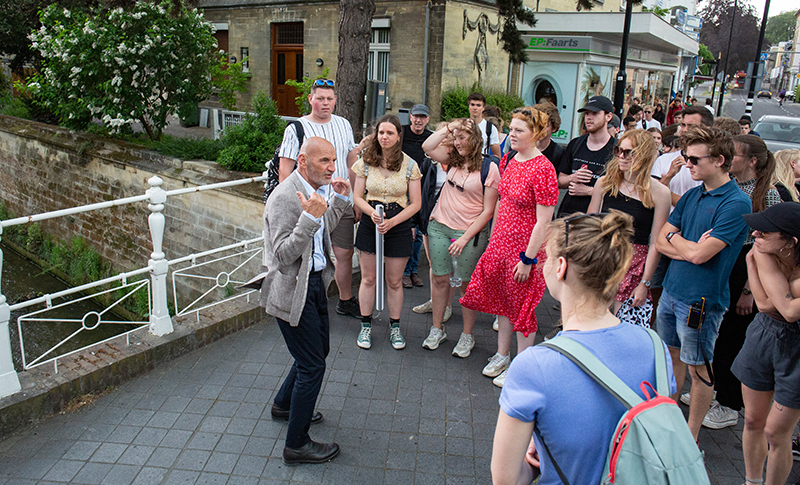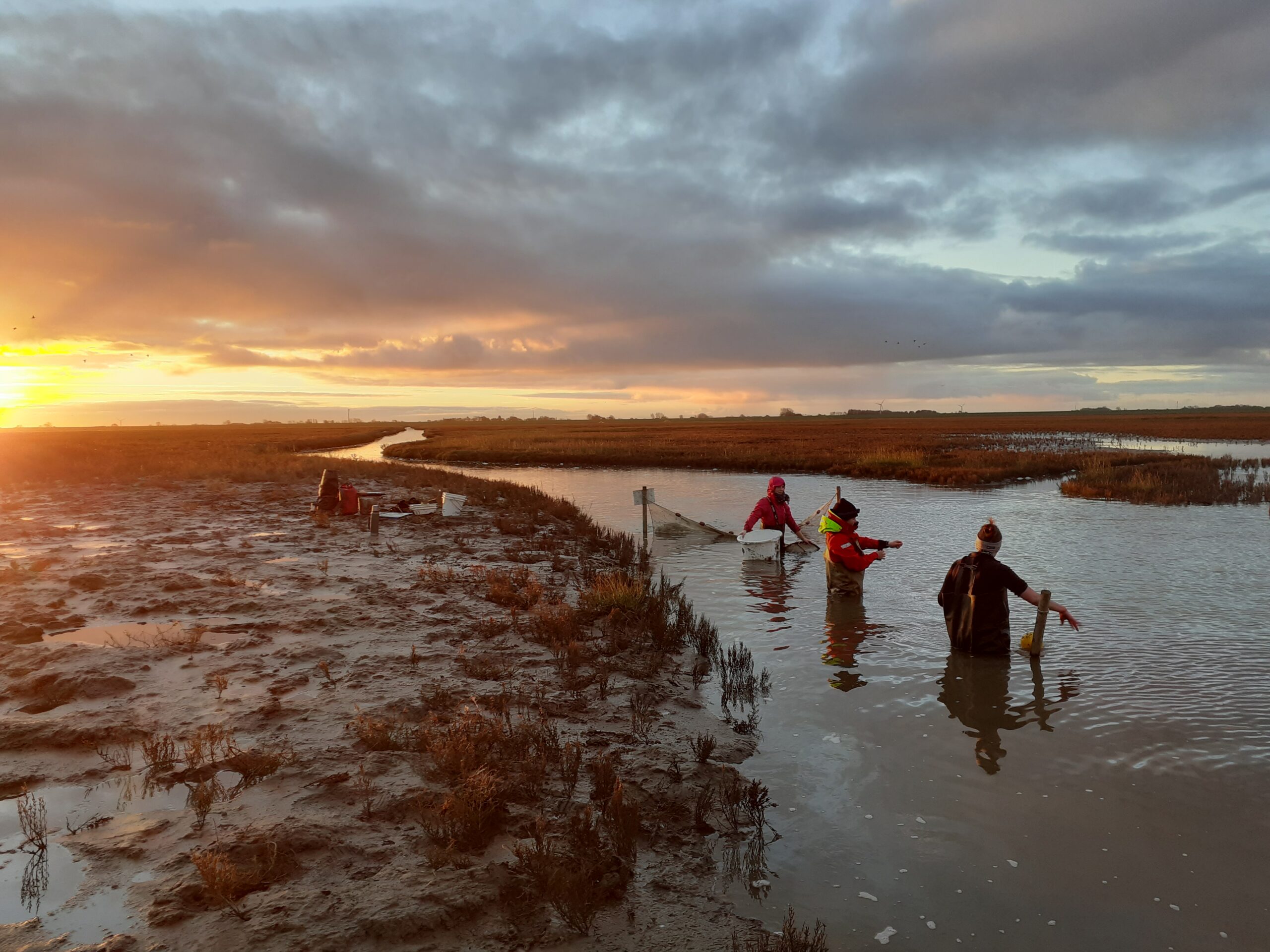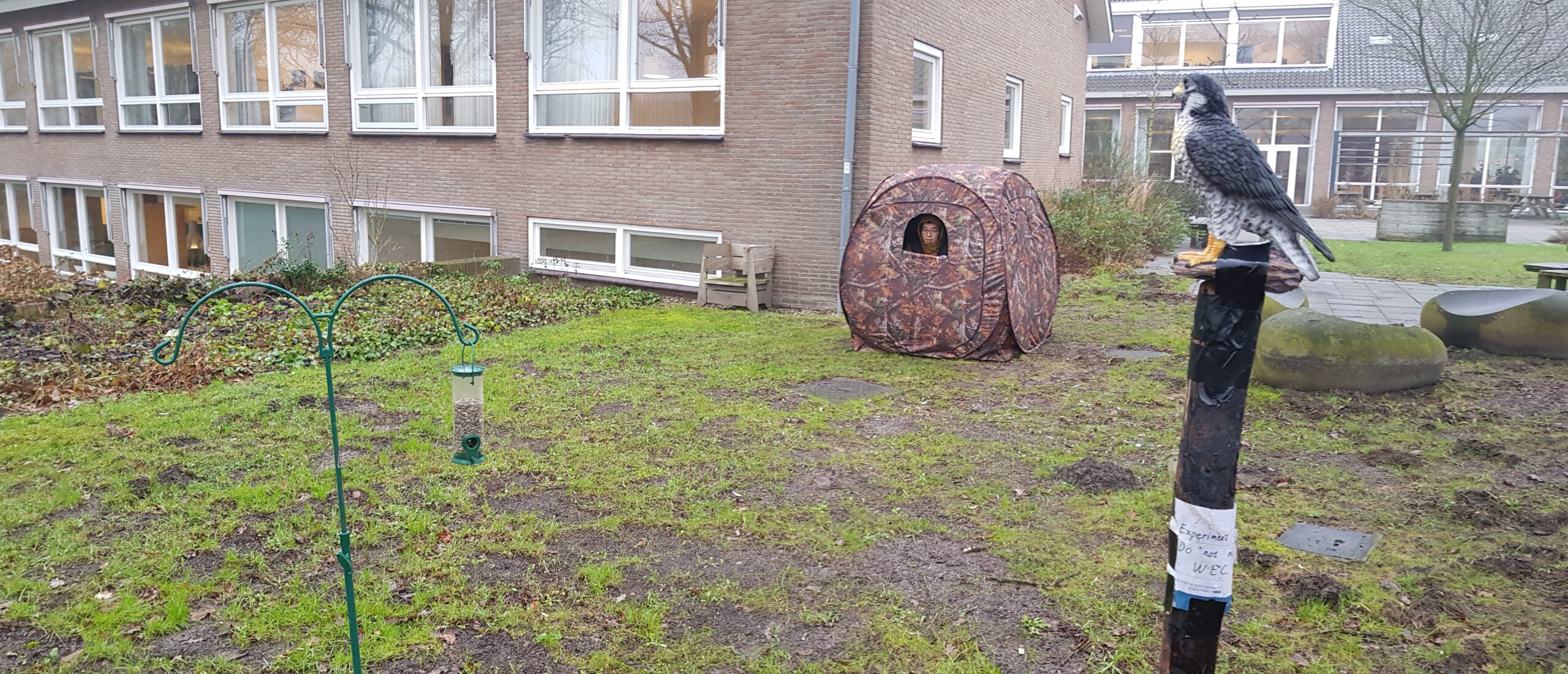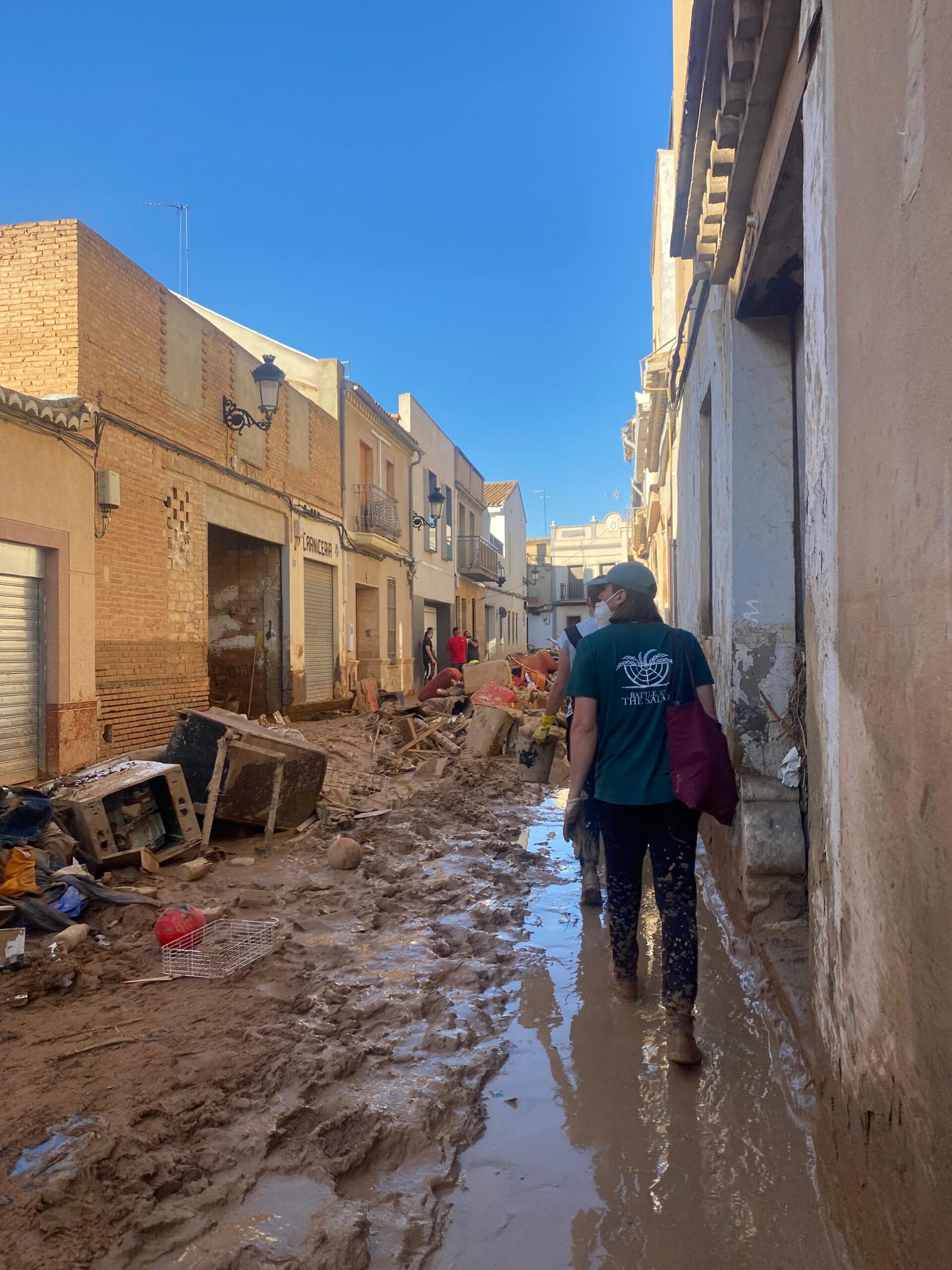First-year students of International Land and Water Management went to the south of Limburg province for 10 days to find out how the landscape was affected by last summer’s flooding and to ponder possible measures the region could take to be better prepared for the consequences of extreme weather. Resource went along for a day in the sweltering south.
The van slows down and comes to a stop on a dirt road running past a field of sugar beets. Course coordinator Teun Vogel and teacher Katinka van Buuren get out of the van. The Canadian exchange student Katie and her Dutch teammate are crossing the sloping field with a 50-metre measuring tape. In the middle of the field is a strip of bushes: a ‘graft’ in Dutch. ‘Graften’ can be found on many sloping fields in Limburg. They have multiple functions, such as counteracting erosion and stimulating biodiversity. The students halt their measuring activities for a brief consultation with their teachers. Katie: ‘We are looking at whether graften mitigate the effect of flooding.’ Van Buuren: ‘What do you think the answer is?’ Katie: ‘I would say yes. If the water infiltrates the ground there, that slows down the flooding and reduces the amount of water that ends up in the streams and creeks.’
Back in the bus, Vogel tells us that 11 years ago, he too went along to South Limburg as a student. ‘At that time, it was still a shorter excursion of five days, and the focus was on taking measurements. We didn’t have to do any research yet; it was more about learning to measure.’ Over the years, the course grew into 10 days of fieldwork in which students had to formulate a research question and conduct research themselves, Vogel explains. ‘Some first-year students find it quite difficult to come up with a good research question. Last year there was flooding here and the team of teachers knew at once that we should relate the course to that.’
The appliance of science
In the summer of 2021, after days of extreme rainfall, disaster struck in Germany, Belgium and the south of Limburg in the Netherlands. Rivers and streams were transformed into raging torrents that took the lives of more than 200 people and caused tens of billions of euros worth of damage.
If you look at the Geul now, it’s just a small stream
Miraculously, there were no fatalities in the Netherlands, but here too, fear is now rife. How could it go so wrong? Where are the bottlenecks? And what measures can be taken to ensure that every drop of water that falls or flows stays within the banks of the rivers?
At the invitation of the mayor of Valkenburg aan de Geul – the worst affected municipality in the Netherlands – 63 first-year students set about tackling these questions during the Design in Land and Water Management 1 course. In this course, students get to apply pretty much everything they learned in their first year. They do research in an assigned area upstream of Valkenburg. Among the things they examine is the impact of agriculture, nature conservation and landscape design on the soil and water.
Reading the landscape
The students take measurements, talk to stakeholders, ‘read’ the landscape and make transects. ‘A transect is a cross-section of the area, the aim of which is to understand it better,’ says Vogel from behind the steering wheel as he and Van Buuren drive through the rolling Limburg landscape to check in with the groups of students in the field. ‘With a transect you can map how steep the hills are, what is growing where, whether the soil structure changes with your altitude in the area, and so on. You can take measurements along a transect and see, for example, where water infiltrates better or how people living in different places in the area think the landscape should be managed. It is a nice way of making your research more tangible and getting it across to people.’
A little later, we are driving through one of the longest valleys in the Netherlands. ‘This is one big bathtub, really,’ says Vogel. ‘We are high up in the bathtub now. When it pours with rain here, all the water runs downhill. That is why there are basins all along the road to catch the water. They are meant to slow the water down. Only there were too few of them, because if it rains hard for too long, the basins overflow and the water just pours downhill like crazy.’ He points out a cycle path under construction. ‘You can see that they are building a drain next to it. It’s important to give a lot of thought to how to collect water. After a short pause: ‘This is the purpose of the course, really: to get students looking around them like this. So that they ask themselves how high the highest point is and how low the lowest point, which direction the water flows and what interventions might be possible to slow that water down.’
Vogel and Van Buuren leave by bus for the meeting point to pick up students for the afternoon programme in Valkenburg. Along the way, we regularly encounter groups of young people cycling with one hand on the handlebars and the other holding an auger, a tape measure, or ranging rods (red and white measuring sticks), pedalling fast to reach the agreed location on time.
Fleeing the water
That afternoon, Mayor Daan Prevoo led a sizeable delegation of WUR students and lecturers through his city. He showed them the places that were the hardest hit, such as the houses with low-lying back yards where the water forced its way in with great violence, and one of the listed buildings where a fire broke out due to a short circuit. Shocking, says student Emiel. ‘It’s amazing to see how high the water was. If you look at the Geul now, it’s just a little stream.’ Emiel enjoys doing research in small groups. ‘Because you actually go into the field with measuring instruments and your own research question.’ It’s not all plain sailing, though. ‘We assumed we would be able to take water samples, but it has been dry for a long time now. We are hoping for rain. The forecast is for rain today and tomorrow, which would be good for our research. And for me personally too, because I’m hot.’
The group arrives at the Geul. Where the historic Emma Bridge stood until last year, there is now a temporary bridge made of steel tubing. The stone bridge was not strong enough to withstand the force of the water. While the mayor is talking about this, dark clouds are gathering. Suddenly, a strong wind blows up and it starts to rain. The group quickly retreats into a passageway in an apartment block.
When you see the damage with your own eyes, you know why you are doing this degree
After a short break, they attempt to resume the tour, but the thunderstorm soon breaks and the rain comes down in torrents, with a deafening clatter. Those who do not find shelter are completely soaked in a matter of seconds. Chaos ensues: students and teachers start hurrying, one group tries to take shelter under a roof, others run for it. After a while, the sheltering students give up and start running too, the mayor leading the way and shouting: ‘Back to the town hall!’
Squeaky shoes
As the storm rages outside, the sodden group drips into the council chamber with squeaky shoes. ‘Just imagine,’ says Prevoo. ‘What you have just experienced, but going on for days on end. And in the middle of the night, things go wrong: the water pours in unceasingly, in some houses up to a height of 1.80 metres. There is no light because the power is out. You stand there in cold water up to chest height. You can hear the roar of the water and people screaming and shouting.’ Rescue workers have post-traumatic stress from it, Prevoo says. ‘There was a father standing in the water with a nine-month-old child in his hands. He handed the child to his partner and a few moments later he was knocked down by a scooter that was floating past. He survived, but imagine if he had still been holding his child when he was pulled underwater.’
All things considered, it is a miracle there were no fatalities, says Prevoo. ‘The stories just say that the Geul flooded, but this was an absolute tsunami of rainwater from a very large area. The soil was waterlogged, the basins were full. Once the water starts moving, there’s no stopping it.’ He calls the extreme weather a consequence of climate change. ‘Can we still prevent that? No. But with the right measures in the landscape, we can manage the consequences better.’
Own eyes
The tour and the mayor’s story made a big impression on student Youssef. ‘You can read about it in books, but when you see the damage with your own eyes, like the fact that the bridge is no longer there and how high the water was in the houses, then you know why you are doing this degree.’ He can see himself working in this field later. ‘Here the problem is water, elsewhere it might be drought or food shortages. I think it would be great to be able to do my bit. I’ll take the basic skills that we learn here with me.’

 Mayor Daan Prevoo tells students about how the normally so peaceful River Geul turned into a raging torrent last year. Photo Bert Janssen
Mayor Daan Prevoo tells students about how the normally so peaceful River Geul turned into a raging torrent last year. Photo Bert Janssen 

